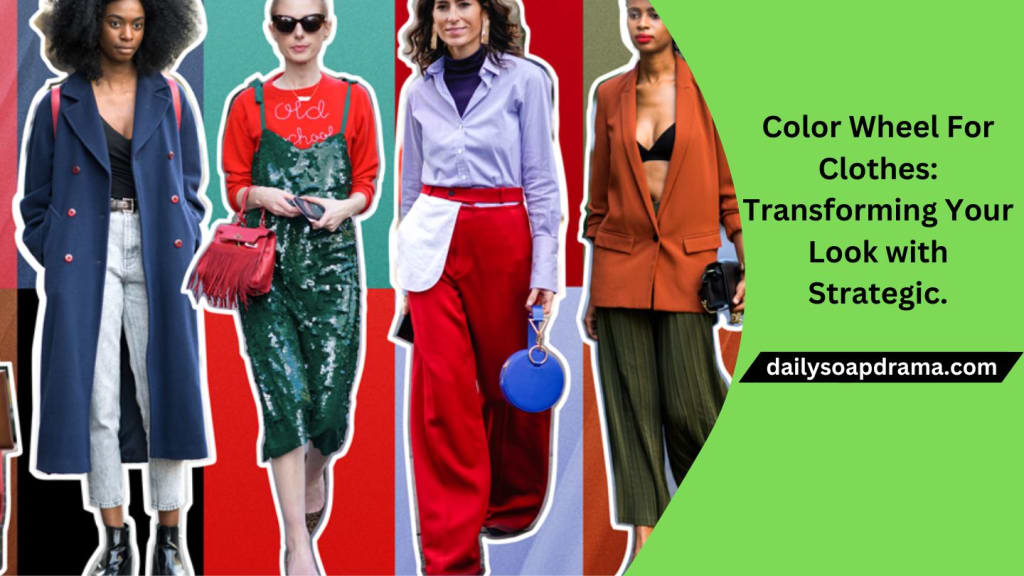
Understanding the color wheel for clothes is essential for people looking to improve their fashion game. Knowing how to mix and match colors allows you to create fashionable and eye-catching clothes. This article covers the fundamentals of the color wheel, how to find colors that compliment your skin tone, color combinations to test, and how to apply the color wheel to apparel. Prepare to take your fashion sense to the next level!
What Is The Color Wheel
Color Wheel For Clothes:
The color wheel is a circular visual representation of hues. It is beneficial for individuals to comprehend the relationship between colors and the ways in which they can be combined to produce harmonious color schemes.
Sir Isaac Newton designed the current color wheel that we know today in the 17th century. He arranged the colors in a circle, with the fundamental colors equal distances apart. Over time, artists, scientists, and designers have polished and built on it for use color wheel for outfit.
If you want to Understanding clothing colour wheel is a must if you want to take your trending fashion game to the next level? Let's explore the three distinct color schemes available on the wheel and how to combine them to produce amazing outfits.
Recommended to read: Fashion Trends for Teenage Guys: The Ultimate Style Guide
The Color Wheel For Clothes
Primary colors
First, there are the primary colors. These are the original colors: red, yellow, and blue. They serve as the foundation for all of the other colors on the wheel. Without them, we wouldn't have the magnificent color palette we know and adore.
Secondary colors
Secondary hues follow in green, orange, and purple tones. Two main colors used combined produce this. Perfect for accentuating a flash of color in your outfit, they are vivid and lighthearted.
Read also: The Top and Worst Fashion Trends of 2004
Tertiary colors
Tertiary hues present a somewhat more complicated picture. Mixing a basic color with a secondary color produces these. See vivid chartreuse or deep magenta. These hues are for the daring and brave and adventurous!
Color Temperatures
Temperature is another approach to arrange colors. Warm colors span red to yellow. Cool colors span green to violet. "Colorless" and comprising black, gray, white, brown, and various hues in between, neutral colors are While cold colors tend to recede and help the observer to rest, warm colors seem more dynamic and often stir or stimulate the observer.
Besides, humans also separated colors according to temperature:
warming colors
Red, orange, and yellow are the blazing colors that truly bring you life. They're ideal for boosting confidence and creating a statement.
Cool colors
Conversely, cold hues, blue, green, and purple, are calm and collected. They are ideal for a more modest appearance and radiate tranquilly.
Read also: Fall Fashion Trends 2024: Items I’m Coveting
Neutral colors
Any clothing consists mostly on neutral hues. On the wheel, black, white, gray, and brown are adaptable colors that go with any other hue. They serve as the sort of glue keeping your clothes together.
How then may one use the color wheel to generate striking combinations? On the wheel, search for colors either opposite each other or close by one another. These hues will look good together and accentuate one another.
Knowing this helps you to design clothes that are especially you. Fashion is all about self-expression, hence don't hesitate to try several color combinations. The opportunities are limitless!
How to Mix & Match with the Clothing Color Wheel
Color can make a huge impact in fashion. The color wheel is an essential tool for anyone who wants to design visually pleasing clothes. But how can you apply it effectively? Here are some rules to bear in mind while using the apparel color wheel.
Try analogous colors: Analogous colors are those that appear adjacent to one another on the color wheel, such as blue and green. When used together, they form a more balanced and delicate color scheme. For example, matching a blue shirt with green jeans results in a serene and restful appearance.
Use complementary colors: Colors that are opposite each other on the color wheel, such as blue and orange, are considered complimentary colors. When worn together, they form a dramatic contrast that may add intrigue and depth to your ensemble. For example, wearing a red shirt with green jeans results in a powerful and lively look.
Identify warm and cool colors: Warm colors evoke a feeling of vitality and enthusiasm, whilst cold colors offer a relaxing effect. Warm colors call emphasis to a certain region or feature, whereas cool colors provide a more relaxed appearance.
Following these guidelines will allow you to use the color wheel to create visually appealing and harmonious ensembles. Remember, fashion is all about self-expression, so don't be afraid to try out new hues and combinations.
Other Considerations
Color Wheel For Clothes:
Match colors to your skin tone.
Try to match your color choices to your skin tone. Cooler colors, such as navy, blue, and green, appear best on light or yellow-toned skin, whereas warmer colors, such as gold and amber, look better on darker skin tones.
Keep color families together.
Aim to keep color families together. For example, pair pastel colors with other pastels, jewel tones with jewel tones, and so on.
Match hues from the same material kind.
Natural hues of particular materials should be matched. For example, if you wear dark leather shoes, select a dark leather belt.
Examples Of How Tailor Bros Uses The Color Wheel In Men's Clothes
Understanding the fundamentals of the color wheel is vital for constructing timeless and traditional men's suits. The garment color wheel teaches Tailor Bros how to create harmonious color combinations by understanding how various colors interact. It is represented in our collections over four seasons.
To produce timeless suits and men's wear, adhere to traditional hues like black, white, gray, navy, and beige, as well as tones of green, brown, and burgundy. These hues are flexible and may be matched in a variety of ways.
For example, a navy suit can be combined with a light blue shirt and a burgundy towel to create a traditional and timeless style. For a more contemporary look, match a gray suit with a white shirt and a green tie. Subtle patterns and stripes in these hues can also help to provide interest and depth to the overall effect.
The colors used in a single Tailor Bros suit guarantee that it is coherent and does not become overbearing.
Conclusion
In conclusion, understanding the color wheel for clothes is crucial to creating a cohesive and stylish wardrobe. So take the time to experiment with different color combinations and find what works best for you. Knowing the color wheel can help you to always look and feel your best in your wardrobe.
About the Creator
Enjoyed the story? Support the Creator.
Subscribe for free to receive all their stories in your feed. You could also pledge your support or give them a one-off tip, letting them know you appreciate their work.





Comments (1)
Interesting to know about this. Thank you for sharing.